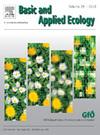利用综合种群模型分析地理位置和当地气候对油麻种群的影响
IF 3.5
2区 环境科学与生态学
Q2 ECOLOGY
引用次数: 0
摘要
许多植物属,包括Fagus属,都表现出种子作物的间歇性和高度时变的生产。尽管人们已经在广泛的领域研究了这种模式,但很少有研究全面地考察了各种相关因素。首先,我们建立了一个新的综合种群水平的种子生产过程模型,并在一个具有详细的花和种子生产定量数据的试验点上测试了该模型对油葵种子生产年际变化的再现能力。其次,为了探索Fagus crenata空间变异机制的假设,并分析地理和气候变量的影响,我们将日本北部550 km范围内102个Fagus crenata种群20年的粗略定性数据(种子等级)拟合到上述过程模型中,包括不同的平均气候条件和纬度遗传差异。我们发现在试验点的花和种子的观测数量和预测数量之间有很好的一致性。仿真结果表明,该过程模型较好地再现了观测到的桅杆模式。102个地点的拟合数据使我们能够提出新的假设。夏季高温作为天气提示的效应指标随着纬度的增加而降低,这可能反映了与纬度相关的遗传分化。逃避昆虫捕食指标与冬季降水呈显著正相关,这可能是由于大降雪地区绿腹草的主要种子捕食者存活率较低所致。这些假设与桅杆模式的空间变化有关,应在未来的研究中加以检验。该过程模型可用于预测气候变化对Fagus等属植物生长模式的影响,提高森林生态系统管理效率。本文章由计算机程序翻译,如有差异,请以英文原文为准。
Disentangling the effects of geographical location and local climate on masting in Fagus crenata using a comprehensive population model
Masting, the intermittent and highly temporally variable production of seed crops, is exhibited by many plant genera, including Fagus. Although patterns of masting have been investigated over a wide range of areas, very few studies have comprehensively examined the various related factors. First, we developed a new comprehensive population-level process model of seed production and tested its ability to reproduce interannual variation in Fagus crenata seed production at a test site for which detailed quantitative flower and seed production data were available. Second, to explore hypotheses for the mechanisms of spatial variation in masting in Fagus and disentangle the effects of geographical and climate variables, we fitted coarse qualitative data (seeding rank) for a 20-year period for 102 populations of Fagus crenata across 550 km in northern Japan to the process model above, encompassing variable average climate conditions and latitudinal genetic divergence. We found good agreement between observed and predicted numbers of flowers and seeds at the test site. A simulation demonstrated that the process model reproduced the observed masting pattern well. Fitting data for the 102 sites allowed us to develop new hypotheses. The indicator of the effect of higher summer temperatures as a weather cue for masting decreased with latitude, possibly reflecting latitude-associated genetic divergence. The indicator of the evasion of insect predation was positively correlated with winter precipitation, possibly due to poor survival of the primary seed predator of F. crenata in heavy-snowfall areas. These hypotheses related to spatial variation in masting patterns should be tested in future studies. The proposed process model will be useful for forecasting climate-change impacts on masting patterns in Fagus and other genera, improving the efficacy of forest ecosystem management.
求助全文
通过发布文献求助,成功后即可免费获取论文全文。
去求助
来源期刊

Basic and Applied Ecology
环境科学-生态学
CiteScore
6.90
自引率
5.30%
发文量
103
审稿时长
10.6 weeks
期刊介绍:
Basic and Applied Ecology provides a forum in which significant advances and ideas can be rapidly communicated to a wide audience. Basic and Applied Ecology publishes original contributions, perspectives and reviews from all areas of basic and applied ecology. Ecologists from all countries are invited to publish ecological research of international interest in its pages. There is no bias with regard to taxon or geographical area.
 求助内容:
求助内容: 应助结果提醒方式:
应助结果提醒方式:


